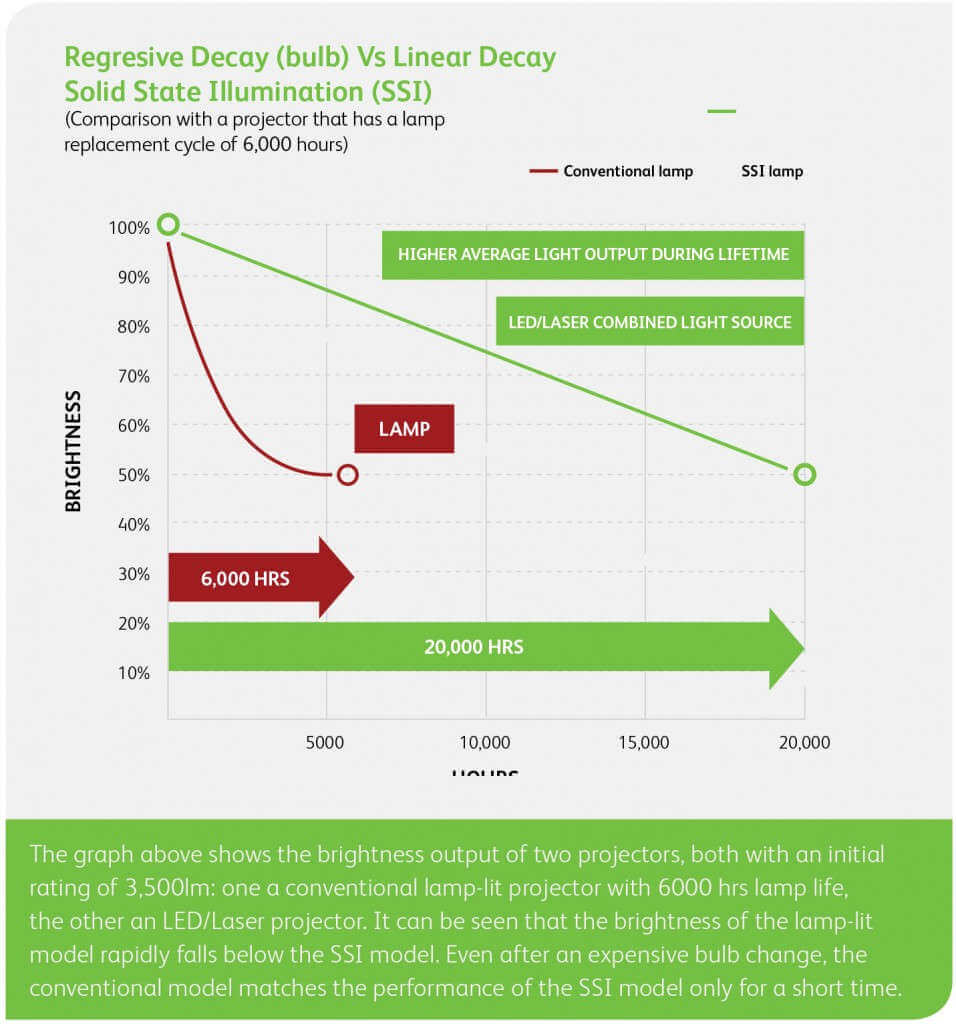CLEAR ADVANTAGE FOR LAMP-FREE PROJECTORS in the 21st Century
The use of the projector as a tool for visual communication and teaching has been restricted by performance limitations of the conventional lamp-lit projector including:
Lamp life – A projector requiring a lamp is subject to the decay curve associated with the conventional bulb. Projector bulbs have a limited life expectancy varying, according to manufacturers’ recommendations, between 1,500 hours to 6,000 hours. Manufacturers recommend that a bulb is no longer functional and must be replaced when its brightness falls to 50% of its initial output.
If we assume that in a university setting a projector might be in use for 48 hours per week for 40 weeks a year, it can be seen that the university must budget for a lamp-change approximately yearly – or face deterioration and possible failure of essential teaching equipment. It is also relevant to consider that, as the PT-RZ Series has a life of 20,000 hours, this university would need to budget for as many as 13 lamp changes to keep their projector operational.
Warm-up/Cool-down time – Projectors need to be operated within a very specific temperature range. In the case of conventional lamp projectors, a carefully engineered airflow system is essential to avoid catastrophic damage to the lamp. In addition, the lamp requires over 30 minutes to reach a stable state; consequently, frequent on/off cycles will deteriorate the lamp faster. For this reason a conventional projector needs a warm-up time of up to two minutes before it can achieve operational brightness. It’s also essential that on closing down it must remain connected to the power supply during cool-down time to ensure its fans continue to cool the bulb.
Not surprisingly these requirements make the conventional projector cumbersome in the context of a fast-moving teaching session. The tutor must either keep the projector switched on throughout his lecture, and accept an uncomfortably hot and possibly darkened room – or accept a pause of two minutes before he can respond to a student’s question. Either way he must switch off the projector five minutes before the end of the lecture to ensure it can be fully cooled before he locks up the lecture room.
The Panasonic LED/Laser Projector, on the other hand, operates at a much lower temperature and provides a quick on/off technology.
Power consumption adjustment – Conventional projector lamps run at 100% of their power requirement, which means producing 100% of the brightness, regardless of the brightness of the image they are projecting. For darker contents additional technology reduces the amount of light projected to the screen by either absorbing the additional brightness within an LCD panel, or reflecting it away from the light path. Both systems produce additional heat which has to be dissipated from the projector.
LED/Laser diodes on the other hand are dimmable light sources. They will use 100% power only when full brightness is called for. In dynamic mode, or with the EcoSave feature, when projecting a typical mixed output of darker pictures the Panasonic LED/ Laser light source will automatically reduce its power consumption – and its heat output. It can rapidly be seen that the LED/Laser projector represents a major advance in terms of operational efficiency and flexibility.
All types of light source (car headlights, household bulbs etc.) show brightness decay and a limited lifetime. They are consumable items. Conventional projector lamps show a Regressive Decay. This means that a lot of initial brightness is lost in the early hours of operation. The decay curve then flattens out before finally reaching 50% of initial brightness, at which point the bulb is no longer functional and must be changed. This means that a conventional projector bulb will spend as much as half of its life operating at close to half of its full capacity. LED/Laser light sources on the other hand when engineered and cooled properly, display a Linear Decay – so, the projector loses operational brightness much more slowly and in a steady decline. This means that, soon after starting its lifetime, an LED/Laser projector will be providing more brightness than its equivalent conventional lamp-lit projector.
Sources for this information and additional reading can be found on at the Panasonic, and Rave Publications websites.
Promoting performing projectors!


![20694_LED whitepaper_v3[2]-3](http://www.avbend.com/blog/wp-content/uploads/2016/01/20694_LED-whitepaper_v32-3-1024x600.jpg)
